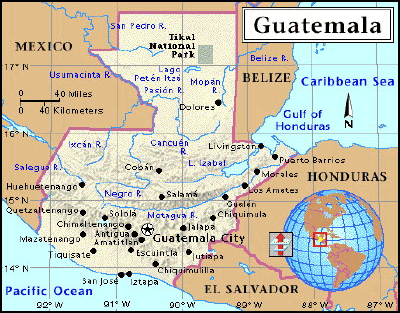Guatemala Huehuetenango

Way, Way Tasty
As in other parts of the Americas, coffee was introduced to Guatemala by the Spanish, looking to profitably exploit the labor of their Mayan subjects. After independence in 1838, coffee cultivation was neglected until the 1870’s, when it was revived by German businessmen. Prior to WW II German nationals controlled over 60 percent of Guatemala’s coffee output, which was exported to Germany.
In 1942, following its declaration of war against the Axis, the Guatemalan government expropriated the huge German-owned plantations. With the help of United States agricultural experts in the 50’s, these confiscated plantations were partitioned into small holdings and distributed to the farm families who worked the land. This egalitarian impulse, leading to increased coffee productivity and quality, was sadly abandoned amid a 30-year stretch of guerrilla wars, Cold War coups, and counter revolution.
 Topographically, Guatemala is dominated by three mountain ranges, stretching across the country, north to south. The majority of the population subsists on the picturesque high plateaus of the Sierra Madre range, ringed by active volcanos, clear alpine lakes, and frequent earthquakes. The high altitude, mild temperatures, mineral rich volcanic soil, and plentiful rain (average 80 inches/year) add Guatemala to the list of lands favored with ideal conditions for growing great, complex coffees.
Topographically, Guatemala is dominated by three mountain ranges, stretching across the country, north to south. The majority of the population subsists on the picturesque high plateaus of the Sierra Madre range, ringed by active volcanos, clear alpine lakes, and frequent earthquakes. The high altitude, mild temperatures, mineral rich volcanic soil, and plentiful rain (average 80 inches/year) add Guatemala to the list of lands favored with ideal conditions for growing great, complex coffees.
“The mountain-grown coffees (of Guatemala) make a handsome roast, are of full heavy body and excellent cup quality.” William Ukers, All About Coffees (1935)
Guatemala is home to many legendary coffee apellations, including Coban, Antigua, Atitlan, and Freihanes. In the north, at over 5000′, lies the most remote growing region, Huehuetenango (way-way-te-non-go). Augmenting regional distinctions, Guatemalan coffees are sometimes sold under estate names, like Santa Barbara or Casa Ruiz. The “Strictly Hard Bean” (or SHB) grade is generic for the premium, export grade of large, high grown, distinctive long bluish beans, produced by the washed method in fine “euro-prep” style.
Guatemalan single varietals are a ubiquitous staple of gourmet coffee roasters, prized for their consistent quality, full body, balance, and unique spiciness. At Coffee Works, Guatemalan is also a frequent component of full bodied medium blends; Bold enough to stand up to the fattest Indonesian while adding both aroma and acid brightness to the liaison.
Our choice this month is a select SHB from Huehuetenango, a region we prefer both for its consistent quality and from a belief that the higher altitudes and remoteness of the region make it least likely to be compromised by productivity “advances”, like mechanical-harvesting and hybridization. While “Antigua” may be the better known Guatemalan region, many coffee gurus, like Tim Castle, author of The Perfect Cup, have begun to identify Huehuetenango as their favorite.
Our current selection displays the traditional Guatemalan qualities of peppery aroma, “smokiness,” and satisfying body. Its delightful savory spiciness lingers on the palate. Roasted “full-city” (medium dark), it is a mild, balanced coffee that can be enjoyed all day long without bitterness or harshness. What more could we ask of a late Spring, endless Summer coffee?


